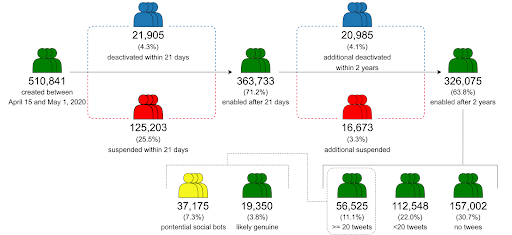Unmasking the True Nature of New Twitter Accounts
With over 300 million monthly active users, Twitter sees thousands of new accounts created daily. But how many of these new accounts are genuine, and how many are ephemeral users who quickly cease interactions with the platform? Adopting an innovative approach, we produced a dataset comprising over 500,000 new Twitter accounts created in April 2020. Identified immediately after registration, these accounts were closely monitored for 21 days, with a final status check conducted two years post-registration. This allowed us to shed light on the behavior of Twitter newcomers, as well as on the strategies adopted by the previous Twitter administration to address potentially harmful accounts.
Exploring authenticity and longevity: The Plague of Ephemeral Accounts
Our primary exploration focused on determining the authenticity and longevity of these new accounts. A significant 25% of new accounts faced suspension within their first three weeks. Additionally, 4.3% chose to deactivate. A two-year follow-up revealed that a mere 11.1% of accounts remained active, having produced more than 20 tweets, with many of them exhibiting bot-like characteristics. These findings prompt crucial questions regarding the platform's organic growth and genuine user engagement. Figure 1 delves deeper into these findings, offering a temporal perspective on the fate of new Twitter accounts after 21 days and again at the 2-year mark.

Figure 1: Temporal view of the fate of new Twitter accounts. Deactivations and suspensions in the first 21 days. Subsequent events within 2 years, and identification of genuine active users and potential social bots.
Suspension Patterns and Twitter’s Policy Enforcement
We then analyzed the temporal evolution of these suspensions, in order to gain insights into Twitter's strategy in mitigating the impact of potentially harmful accounts. Figure 2 shows the suspension and deactivation trends during the first 21 days. While Twitter enforces suspensions to halt harmful accounts, deactivation is a voluntary action initiated by the account owner. Remarkably, 70% of suspensions took place in the early hours of the account's 16th day. Moreover, an astonishing 90% of these suspended accounts stopped interacting with the platform within their initial 24 hours, as if they had been "frozen" by Twitter. Overall, these results indicate that Twitter put a substantial effort into curtailing potential threats as soon as possible.

Figure 2: Deactivations and suspensions in the first 21 days relative to account creation.
The Impact of Ephemeral Accounts
Many newly created accounts, while short-lived, made a non-negligible impact. Accounts suspended within their initial 21 days, of which a significant portion showed no activity, constituted 12.4% of all original tweet authors from new accounts. When combining the data from both deactivated and suspended accounts, these entities produced over 10% of all tweets (including retweets, replies, and quotes) and almost 8% of social interactions from new users.
In light of these findings, the previous Twitter administration might have been overly optimistic when reporting figures on user authenticity, especially concerning new accounts. Considering over 120,000 daily new account creations, only an estimated 3.8% appear to demonstrate long-term, genuine user behavior. Undoubtedly, Twitter has faced a significant challenge in attempting to solve the trade-off between platform growth and ensuring genuine user engagement, the latter being paramount to protect its users.
Looking Ahead: Concerns with Restricted Data Access
With Twitter now transitioning under new ownership and even undergoing a rebranding to "X," there have been significant changes in the platform's approach to data accessibility. The decision by Elon Musk to considerably limit access to Twitter’s API has garnered significant attention. Accessing the same detailed data now requires a substantial fee, making it prohibitive for many researchers. This is a pivotal concern. For a platform of such global significance, reduced transparency and inhibited research capabilities could have far-reaching implications.
Reference paper:
Cola, G., Mazza, M., & Tesconi, M. (2023). "Twitter Newcomers: Uncovering the Behavior and Fate of New Accounts through Early Detection and Monitoring".
IEEE Access. 2023. DOI: 10.1109/ACCESS.2023.3282580
Public dataset:
https://data.d4science.org/ctlg/ResourceCatalogue/twitter_newcomers_dataset

